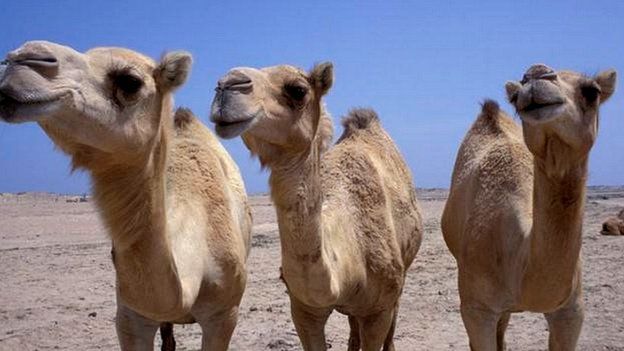Ancient trade routes written in camel genes
- Published

A study of one of the world's most important domesticated animals - the dromedary camel - has revealed how its genetic diversity has been shaped by ancient trade routes.
Scientists examined DNA samples from more than 1,000 one-humped camels.
Despite populations being hundreds of miles apart, they were genetically very similar.
Scientists explained that centuries of cross-continental trade had led to this "blurring" of genetics.
The findings are published in the Proceedings of the National Academy of Sciences.
One of the team, Prof Olivier Hanotte, from Nottingham University, explained that what made the dromedary so biologically fascinating was its close link to human history.
"They have moved with people, through trading," he told BBC News. "So by analysing dromedaries, we can find a signature of our own past."
In search of this signature, the researchers compared samples of DNA - the carrier of genetic information - from populations across the camels' range.
"Our international collaboration meant we were able to get samples from West Africa, Pakistan, Oman and even Syria," Prof Hanotte explained.
Beast of burden
The domesticated dromedary was adopted as a beast of burden around 3,000 years ago and, well into the 20th Century, trade caravans that sometimes consisted of thousands of animals, would transport goods across the deserts of North Africa and the Arabian Peninsula.
Prof Hanotte explained: "People would travel hundreds of miles with their camels carrying all their precious goods. And when they reached the Mediterranean, the animals would be exhausted.
"So they would leave those animals to recover and take new animals for their return journey."
This caused centuries of genetic "shuffling", making dromedaries that are separated by entire continents remarkably similar.
Crucially, this has also ensured that the animals maintained their genetic diversity - constantly mixing up the population. This means that dromedaries are likely to be much more adaptable in the face of a changing environment.
"Climate change, for example, is characterised by rising temperatures, more extreme weather patterns and more areas becoming less suitable for livestock," said Prof Hanotte."
"The dromedary will be our better option for livestock production - of meat and milk.
"It could replace cattle and even sheep and goats that are less well-adapted."
Has domestication shaped how animals think? A study in horses suggests so
- Published10 February 2016
- Published1 April 2016